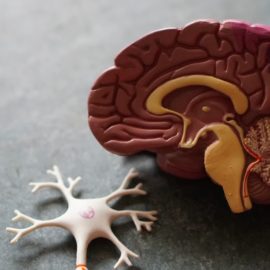

This article is an excerpt from the Shortform book guide to "Outlive" by Peter Attia. Shortform has the world's best summaries and analyses of books you should be reading.
Like this article? Sign up for a free trial here.
What causes chronic disease? Which four chronic diseases are primarily to blame for decline and death in old age? Why is Alzheimer’s disease sometimes called “type 3 diabetes”?
According to physician Peter Attia, the key to avoiding physical and mental decline when you’re older is preventing four specific chronic diseases. He says that they all have one cause in common: metabolic dysfunction.
Keep reading to learn what metabolic dysfunction is and how it contributes to four deadly chronic diseases.
To Live Better, Avoid Chronic Disease
Attia specifically addresses four chronic diseases: heart disease, cancer, neurodegenerative diseases (like Alzheimer’s and dementia), and type 2 diabetes. By chronic, we mean that these diseases progress throughout a person’s life rather than coming and going quickly, like a cold or flu. As you grow older, your chance of contracting these four diseases increases, and they’re responsible for the vast majority of deaths in the elderly. Even if these diseases don’t kill you, they greatly hinder your physical and mental capabilities, reducing your quality of life.
(Shortform note: In Lifespan, David Sinclair argues that aging doesn’t just make you more likely to suffer from disease; rather, it is the disease, and our four “chronic diseases” are all its symptoms. Thus, he asserts that we can uniformly avert them all by reversing the biological markers of aging itself. For instance, as you age, your body accumulates senescent cells—cells that can no longer function nor be recycled, and which damage the surrounding tissue. Theoretically, destroying these senescent cells will slow down the aging process, thereby warding off all chronic diseases caused by old age and increasing your quality of life.)
What causes chronic disease? How, specifically, can you avoid these four particular diseases? Attia notes that, although these diseases cause your body to break down in totally different ways, there’s an incredibly common yet preventable health condition that directly causes all four: metabolic dysfunction. By keeping your metabolism healthy, you can greatly reduce your risk of contracting all four chronic diseases.
(Shortform note: Metabolic dysfunction isn’t the only cause of chronic disease, but it’s the main cause Attia emphasizes throughout the book. He likely focuses on this condition because it’s one you have a great deal of control over relative to unavoidable risk factors like your genetics.)
Next, we’ll explain what metabolic dysfunction is and what causes it. Then, we’ll detail how metabolic dysfunction leads to all four chronic diseases.
Defining Metabolic Dysfunction
Attia explains that “metabolism” is the process by which your body converts the food and other nutrients you consume into energy and materials used to build, repair, and maintain your body. However, if you regularly ingest more nutrients than you need—in other words, if you consume too many calories—your body will start storing them in increasingly unhealthy ways.
Your body converts much of the food you eat into glucose (also known as blood sugar), a form of energy that’s easily stored, transported, and utilized. If your body doesn’t need to immediately burn that glucose as energy, it can store it in healthy ways: in your muscles and liver as a compound called glycogen, or as subcutaneous fat, the healthy layer of fat found under your skin all over your body. However, Attia warns that once this storage is full, your body begins storing this energy in places where it doesn’t belong; for instance, unhealthy visceral fat. This is abdominal fat that surrounds important internal organs and causes dangerous inflammation (an immune response that can cause pain, swelling, and other symptoms).
Eventually, after you’ve consumed too many nutrients over an extended time, tiny bits of fat squeeze their way inside muscle cells. Attia explains that this fat weakens your cells’ ability to absorb glucose from the bloodstream and use it as energy. Your pancreas tries to compensate for this damage by increasing production of insulin, the hormone that helps push blood glucose into cells that need it. Unfortunately, if your cells are overloaded with elevated insulin for too long, they become less responsive to insulin and absorb even less glucose—a condition called insulin resistance. Insulin resistance directly causes all four of the chronic diseases we mentioned before.
The term “metabolic dysfunction” refers to this condition as a whole—insulin resistance is one main component of metabolic dysfunction.
| The Problem With Counting Calories Attia asserts that you begin the process leading to metabolic dysfunction when you consume more calories than your body needs to function. By this logic, the simplest way to improve your metabolism might seem to be counting and reducing how many calories you eat. However, this may not be effective. Calories are a measurement of how much energy a food contains. However, because your digestive system metabolizes different foods in different ways, two foods that contain the same number of calories can cause your body to absorb vastly different amounts of energy. Consequently, they can cause you to produce different amounts of fat. Example: A slice of birthday cake contains about the same number of calories and carbohydrates as a cup of quinoa. But since the cake has been processed and refined, making it easier to digest, your body spends far less energy metabolizing the cake than it does the quinoa. In other words, it doesn’t need to use up glucose and glycogen to digest the cake, so those energy stores remain full. This forces your body to turn more of that excess energy into subcutaneous and visceral fat. The subcutaneous fat is fine, but the visceral fat is dangerous. (Additionally, quinoa contains many more healthy nutrients than a slice of cake, such as fiber, protein, and iron.) Calories can be a helpful tool when tracking them helps you eat less, but they don’t give a very good estimate of how much energy you’re actually retaining in the form of glucose and fat. |
How Metabolic Dysfunction Causes Chronic Disease
How could metabolic dysfunction and insulin resistance cause four wildly different chronic diseases? Let’s examine all four.
First, extreme metabolic dysfunction is type 2 diabetes. Attia explains that you qualify for a diagnosis of type 2 diabetes when you reach a certain level of chronically elevated blood sugar and insulin resistance.
Second, metabolic dysfunction directly increases your risk of cardiovascular disease, Attia states. When your metabolism is dysfunctional, your blood pressure increases, damaging the walls of your blood vessels. This damage increases your risk of harmful cardiovascular incidents by causing plaque to build up along your vessel walls. This may eventually clog your blood vessels or force a clot into the bloodstream, causing a heart attack or stroke.
(Shortform note: Why does metabolic dysfunction raise your blood pressure? The answer isn’t totally clear to researchers yet. That said, one potential reason may be that higher levels of insulin in the bloodstream cause the kidneys to absorb more sodium, rather than allowing your body to excrete it through urine. When your blood retains sodium, it also retains more fluid to keep the ratio balanced, raising your blood pressure—consequently damaging your blood vessel walls and increasing plaque buildup. This is also why people at risk of a heart attack or stroke should consume less dietary sodium.)
Third, metabolic dysfunction provides the perfect environment for cancer cells to grow. Attia explains that cancer cells consume more glucose than healthy cells do, and they use insulin to absorb these vast amounts of glucose. The more insulin is in your bloodstream, the more fuel is available for cancer cells to grow.
Finally, Attia asserts that metabolic dysfunction causes neurodegeneration: chronic damage to your brain. To function properly, the brain needs a lot of energy—typically in the form of glucose—and it depends in part on insulin to get the glucose it needs. In particular, the parts of the brain responsible for memory appear to be more dependent on insulin than other parts. If you trigger insulin resistance in the brain, the memory systems can’t get the energy they need, and neurodegeneration sets in.
(Shortform note: Neurodegeneration and metabolic dysfunction are so closely linked that many researchers refer to Alzheimer’s disease as “type 3 diabetes.” However, this classification isn’t officially recognized, and other experts argue that this label overstates the connection between the two conditions. Some research suggests that treating neurodegeneration purely as an insulin problem is ineffective: Alzheimer’s patients treated with insulin for a year suffered just as much cognitive impairment as a control group treated with placebos.)
The Key Is Prevention
To avoid these diseases, take early preventative action. Although they often appear to strike suddenly, they don’t present crippling physical and mental symptoms until after they’ve slowly progressed for decades inside your body. Attia contends that, by fighting these diseases decades before they present themselves, you’ll often be able to avert them entirely.
Unfortunately, in our current medical system, doctors and hospitals often use a fee-for-service model—this means that doctors get paid for administering expensive treatment, not for prescribing low-cost preventative measures. They neglect to diagnose patients with these chronic diseases until severe symptoms manifest, at which point it’s much more difficult to stall or reverse their progression. For this reason, you can’t just rely on your doctor to keep you healthy—you must take your health into your own hands and proactively work to prevent these chronic diseases.
(Shortform note: When Sinclair discusses the current medical system, he doesn’t specify which countries’ medical systems he’s referring to. Most countries accommodate at least some fee-for-service medical care, even those with single-payer systems (in which taxpayers fund a single governmental healthcare service). However, the extent to which they rely on this payment model varies widely. For instance, the United States’ private system heavily relies on the fee-for-service model, while the United Kingdom’s single-payer system only uses fee-for-service for a few treatments—for instance, dental care.)
| Why Health Insurers Neglect Cheap Preventative Measures Why don’t the entities paying doctors and hospitals push for preventative strategies to avoid disease? In the US, focusing on preventative measures would theoretically spare insurance companies significant expenses in the long run. For instance, paying for a continuous glucose monitor for someone with prediabetes would be much cheaper than paying for a lifetime’s supply of insulin injections or pancreas surgery after that patient has developed extreme type 2 diabetes. However, in the US, where most people swap health insurance providers multiple times throughout their lives, insurance companies aren’t incentivized to make investments in their patients that will only pay off years down the line. It’s likely that their competitors would profit from such a move. Because of this, the healthcare industry in the US is often more focused on the short-term profits of treatment rather than the long-term savings of preventative care. That said, single-payer healthcare systems also struggle with successfully implementing preventative strategies. Getting patients to make life-saving behavioral changes years or decades before their chronic diseases start presenting major symptoms can be challenging. |

———End of Preview———
Like what you just read? Read the rest of the world's best book summary and analysis of Peter Attia's "Outlive" at Shortform.
Here's what you'll find in our full Outlive summary:
- A guide on how to extend the active and fulfilling part of your life
- How to circumvent the mental and physical decline that often comes with age
- The one chronic condition that can cause four of the most deadly diseases






